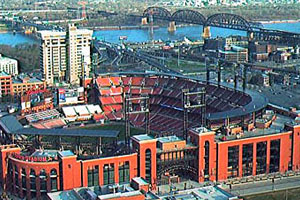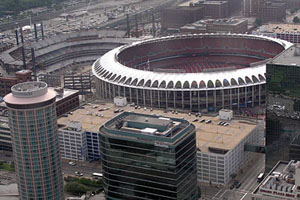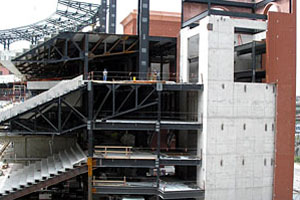On Large Construction Jobs, Planning is Everything
By Masonry

Imagine this: You are the masonry contractor on a job that requires 750,000 hand-laid bricks and 1,000,000 architectural concrete masonry units to be fabricated or obtained, cut and laid in 18 months. Oh yes, and by the way, the structure you are helping to build is replacing an existing structure that must remain at least partially standing during the construction job because it will be in daily operation.
Quite a tall order! But it's one that MCAA member Heitkamp Masonry Inc. and a number of other St. Louis contractors found themselves confronted with when they landed the job of building St. Louis' new Busch Stadium. In 18 months, they not only had to build the new stadium, but the project also took place during baseball season.
The project was performed in two phases. The first entailed building as much of the new ballpark as possible prior to the implosion of the old one. When the old Busch Stadium was imploded, the new in-progress stadium (the second phase) was completed as rapidly as possible. At one point, the old and new structures were only a few feet apart.
Heitkamp Masonry was responsible for the brick and concrete work for the stadium, including restrooms, concessions and outbuildings, as well as the granite, paving and precast work.
How did they pull it off? According to Heitkamp Masonry's Project Manager, Geoffrey Hart, it's all in the planning. "The logistics on a job like that are incredible. It takes about a year of pre-planning before the job, then 10- to 12-hour-a-day supervision while the job is in progress."

During construction, Brennan Tools was able to consistently deliver items right to the job within 24 hours of being ordered. It even had secure on-site containers where materials could be placed for later shifts, so that second- and third-shift deliveries weren't necessary.
"Bill was really a great resource, simply because he was so close to the project," Hart said. "This was mainly because his representatives were down there always to respond to anything we needed at a moment's notice."

Because of their noise level, masonry saws must typically be used some distance from the work being performed, out of safety concern for other tradespersons on the job site.
Early on in the Busch Stadium job, Brennan saw the problem of the tight time schedule and realized that Heitkamp Masonry could not afford to have its saws located a distance away from the job. Brennan knew that Target had a fairly new silent core masonry diamond blade on the market that would reduce the usual screeching noise level to nearly zero, making it possible to work close to the job without adversely affecting the hearing of those around the site.
"I knew how effective the Silent Runner blades were, so I bought the first blade myself and gave it to Heitkamp to try out," Brennan said. "Heitkamp was open to the idea, but skeptical at first. There has been a lot of advertising about 'quiet blades' and contractors are like, 'Yeah right, how quiet is quiet?'"
Because the Silent Runner blade works by resonating inside the blade instead of outside, the high degree of noise normally inherent with such blades is eliminated. Also, it performs as well or better than standard diamond blades, with no loss of performance.
"They tried it and said it was spectacular," Brennan said.
"When you've got a guy on the job eight hours a day, the less noise the better, " Hart said. "It really helped us. It was certainly a silent blade, and didn't give off the sharp, piercing noise that a regular blade would. It kept the contractors working around us very happy."
The careful preparation, fantastic supplier support and smooth supervision paid off. The new Busch Stadium was completed within its near-impossible target date and opened on April 10, 2006, as the St. Louis Cardinals took the field against the Milwaukee Brewers. Though most fans will never know it, it all came about through detailed planning, well executed by contractors such as Heitkamp Masonry and supported by suppliers such as Brennan Tools and Fastening Systems.
About the Author
Masonry, the official publication of the Mason Contractors Association of America, covers every aspect of the mason contractor profession - equipment and techniques, building codes and standards, business planning, promoting your business, legal issues and more. Read or subscribe to Masonry magazine at www.masonrymagazine.com.


















